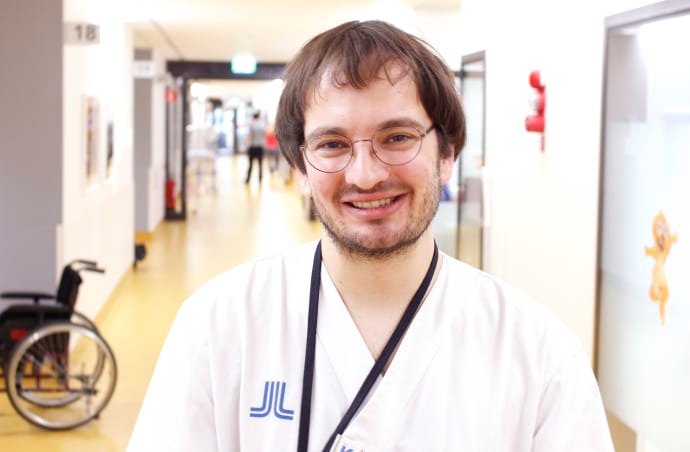Cheap drug may alleviate treatment-resistance in leukemia

A common and inexpensive drug may be used to counteract treatment resistance in patients with acute myeloid leukemia (AML), one of the most common forms of blood cancer. This is the conclusion of a study in mice and human blood cells performed at Karolinska Institutet and SciLifeLab and published in the medical journal EMBO Molecular Medicine. The researchers will now launch a clinical study to test the new combination treatment in patients.
Leukemia is a group of blood cancers that results in excess amounts of white blood cells. There are both chronic forms of leukemia that progress slowly over many years and acute types of leukemia that evolve rapidly. AML affects more than 20,000 people in the United States each year, and the mortality rate is high especially in older patients.
One of the most common drugs to treat AML is cytarabine (ara-C), a cytotoxic drug that interferes with DNA replication. However, many patients do not respond to the treatment because their leukemic cells express high levels of the enzyme SAMHD1, which breaks down the active metabolite of cytarabine, ara-CTP. These patients have a significantly worse survival rate than patients with low leukemic levels of SAMHD1. Therefore, one promising strategy to improve the treatment of AML is to inhibit the effects of this enzyme on cytarabine.
Three substances identified

In this study—co-led by by Sean Rudd at the Department of Oncology-Pathology and Nikolas Herold at the Department of Women’s and Children’s Health—the researchers tested the impact of more than 33,000 different substances on SAMHD1’s ability to break down ara-CTP in leukemia cells treated with cytarabine. The experiment led to the identification of three different substances, so-called ribonucleotide reductase inhibitors (RNRi), that all reduced SAMHD1’s ability to deactivate ara-CTP: hydroxyurea, gemcitabine and triapine.
“Adding any of these three substances significantly improved the effect of the cytarabine-treatment in cell samples with high levels of SAMHD1,” says Nikolas Herold. “This was true for AML samples from both adults and children. In AML-mice, we also saw that the median survival was significantly prolonged when cytarabine was combined with an RNR-inhibitor.”

Hydroxyurea is an inexpensive drug that is used to treat blood diseases such as AML. However, it has not systematically been used in combination with cytarabine. Gemcitabine is a potent drug that is used to treat many different types of cancers, but it can be toxic if given repeatedly. Triapine is a drug currently undergoing clinical studies for cancer treatment. In animal studies, the combination therapies did not exhibit any excess side-effects beyond those already established in cytarabine-treatments.
Clinical study underway
The research group is now planning to move forward with a clinical study that will evaluate the effect of combining standard AML-treatment with hydroxyurea in recently diagnosed patients. The study will be conducted in collaboration with the Swedish AML-group and will begin recruiting patients within a few weeks.
“Hydroxyurea is an approved drug that is already used to treat AML, so we think it has great potential,” says Nikolas Herold. “If our research results can be confirmed in clinical trials, the treatment of AML could be significantly improved also in developing countries with limited resources since hydroxyurea is patent-free and doesn’t cost more than ibuprofen.”
The researchers were also able to show how the RNR-inhibitors affected the SAMHD1-levels mechanistically. These drugs change the intracellular composition of deoxynucleoside triphosphates (dNTP), which are building blocks for molecules. Since SAMHD1 needs dNTPs to activate its enzymatic activity, this effectively abrogates its ability to break down ara-CTP.
The study is the result of an international collaboration with researchers from Sweden, Germany, U.S., and South Korea and has also involved researchers at SciLifeLab, a national hub for molecular biosciences in Sweden.
The study has been funded by the Swedish Children’s Cancer, the Swedish Cancer Society, the Swedish Medical Association, the Clas Groschinsky Memorial Foundation, the Mary Béve Foundation for childhood cancer research, the Harald och Greta Jeanssons Foundation, the Ake Wiberg Foundation, the Lars Hierta Memorial Foundation, the ìShizu Matsumuraî donation, the Sigurd and Elsa Goljes Memorial Foundation, the Swedish Research Council, Radiumhemmet’s Research Foundations, the Torsten and Ragnar Soderberg Foundation, the Stockholm County Council, the Alex and Eva Wallstrom Foundation for scientific research and education, the Felix Mindus contribution to Leukemia Research, The Loo and Hans Osterman Foundation for Medical Research, the Marta and Gunnar V Philipsons Foundation, Karolinska Institutet Foundations, the National Institute of Health and Science for Life Laboratories.
Publication
“Ribonucleotide reductase inhibitors suppress SAMHD1 ara-CTPase activity enhancing cytarabine efficacy”, Sean G Rudd, Nikolaos Tsesmetzis, Kumar Sanjiv, Cynthia BJ Paulin, Lakshmi Sandhow, Juliane Kutzner, Ida Hed Myrberg, Sarah S Bunten, Hanna Axelsson, Si Min Zhang, Azita Rasti, Petri Mäkelä, Si’Ana A Coggins, Sijia Tao, Sharda Suman, Rui Mamede Branca, Georgios Mermelekas, Elisée Wiita, Sun Lee, Julian Waldfridsson, Raymond F Schinazi, Baek Kim, Janne Lehtiö, Georgios Rassidakis, Katja Pokrovskaja Tamm, Ulrika Warpman-Berglund, Mats Heyman, Dan Grandér, Sören Lehmann, Thomas Lundbäck, Hong Qian, Jan-Inge Henter, Torsten Schaller, Thomas Helleday & Nikolas Herold, EMBO Molecular Medicine, online Jan. 17, 2020, doi: 10.15252/emmm.201910419
